 ™
™TRADITIONAL MOUNTAINEERING
™
www.TraditionalMountaineering.org
™ and also
www.AlpineMountaineering.org
™
 ™
™
FREE BASIC TO ADVANCED
ALPINE MOUNTAIN CLIMBING INSTRUCTION™
Home
| Information
| Photos
| Calendar
| News
| Seminars
| Experiences
| Questions
| Updates
| Books
| Conditions
| Links
| Search
![]()
A snow cave can save your life or it can kill you. Let me be clear: parents who send their children off into the snow with the admonition "If you get lost, just dig a snow cave and you will be OK" are creating a false sense of security that can be deadly.
Parents should say:
"Don't get lost,
'stay found' - you
can't depend on following landmarks or your foot prints back to safety - stay together with your
friends and know how to get back. Don't get wet from sweat or the from the outside
because if you have to stop, you will be in danger of getting
hypothermia
even in 50 degree weather. Be
especially mindful of the wind because it can drag your temperature down very quickly
if you are wet and without hat,
gloves and a wind/rain jacket and pants. Wear your wool, not your cotton and be
sure you have the Ten Essential Systems in your day pack! Know when you need to
return, but don't wait until you or a friend start to get really cold."
No, I have not found statistics on deaths in "snow caves", but I recall the report of the 14 year old boy who crouched in a "snow cave" for several days out of bounds in California and died in the hospital from his cold related injuries and the woman hunter in Eastern Oregon with a twisted ankle who recently lost her lower legs after a week in an "emergency snow cave". Recently, an Olympic Hockey player lost both feet after staying in an emergency snow cave. The best advice is stay with others, stay found, stay dry, keep out of the wind and keep eating, drinking, awake and moving your muscles to avoid hypothermia. Read on and you will see why a snow cave may not be a good option.
Building a safe snow cave for two people can take at least two or three hours of hard work using a snow shovel or two. You can't build a snow cave without tools. Once you build the cave, you will need insulation from the snow. If you do not have an insulating pad your compressed clothing will not keep the cold from conducting heat from your body as you sit or lie on the hard snow. Always carry a shovel, (a bivy sack) and at least a light 3/4 ensolite pad strapped to your winter sized daypack.
You need to know how to build a safe snow cave. Here are some things to know:
Choose a cave site away from avalanche danger and possible tree fall. Obvious, you say. But an avalanche was not so obvious to the two snow-shoers in the Washington Cascades, who were discovered buried in their tent for two weeks, by a small slide at the edge of the clearing that was used as a helicopter landing zone during the search for them by the local Sheriff's SAR Unit!
Find a site on the lee side of a small short hill. This will be a traditional deposition zone for wind driven snow. There will be more snow to work with and it will be more consolidated. Many would be recreational snow cave builders have been frustrated by trying to work with four feet of dry powder snow. Find deep consolidated snow or wait to try again another day.
Consolidate the snow yourselves. You can change the qualities of a foot or two of powder snow by tramping it vigorously with skis or snowshoes. Boots will not work very well at all. (You would need to do this to consolidate a platform for a four season tent as well.) Do not work up a sweat. Take off your insulating layers, put on your GorTex pants and jacket, gaiters, gloves and hat. You will have to rest and wait a few minutes until the snow consolidates.
You are likely to become drenched with snow and sweat. Do your best to stay dry. To wet out the least amount of insulation, work in you base layers and gortex layers. Stay out of the wind.
First, dig a four foot diameter tunnel into the hill, piling the snow down hill. When you have your tunnel mined about eight feet horizontally into the snow, start excavating up and out until you can sit up on the snow that will become your sleeping platform for your two or several sleeping pads, bags and bivys. Create a smooth arched chamber for the cave that will allow the melting snow to run down the sides and not your sleeping bag bivy. Then excavate an eighteen inch wide trench about eighteen inches below your sleeping platform out to the doorway for the new cave floor . When you have dug out the cave interior and moved all the excavated snow out of the way, go outside and completely close the entrance to your four foot tunnel with blocks of snow cut from the disturbed consolidated snow you have depositing down hill. Be careful not to break your shovel by prying too hard. Wait until the wall consolidates. Stay warm, drink hot chocolate and then cut a two by two foot pit or larger and a new eighteen inch tunnel entrance into the trench you created.
This technique will place the sleeping platform just above the top of the new entrance tunnel. This design will trap the heat from your bodies and keep the inside temperature at a constant 32 degrees.
Make good steps into your pit, many folks have been injured slipping into the cave pit. Make a cooking area and seats around this outside pit. Build walls to break the wind that will come down the mountain as evening cools to air. Create a potty area complete with blue bags. Oh what fun!
Experience shows us that moving so much snow requires two or more shovels and lots of elbow room. Take turns cutting and excavating and throwing the snow down hill. Don't work too hard. Try to stay dry. Take breaks to eat and drink. Smooth the snow inside the cave to minimize melt drips and maximize strength of the arched dome shape.
With a pole or traditional long ice axe handle, make two holes in the roof for air - not through the thinnest part, a minimum of 12 inches, but at angles off to the side. Block the entrance tunnel with your empty packs, not with blocks of snow which can freeze and obstruct a hasty exit. Most snow cave campers have a candle or two in niches cut in the walls and lined with reflective aluminum foil. A candle or two in a cave for two or three is unlikely to produce a lethal build-up of carbon monoxide, the silent killer. However, a stove will surely build up a nice lethal dose of carbon monoxide to "lull you to sleep". A build up of carbon dioxide is likely to awaken folks by triggering a natural reflex: gasping for air. Then it will be time to clear new snow from the air holes and the doorway. Keep shovels inside to dig out snow blown into the door pit. Gear left outside may easily be buried and lost. Mark the entrance pit and thin roof of your cave with wands, skis or poles.
Cooking in a cave or snowbound tent is thought to have contributed to the death of more than one high altitude climber from carbon monoxide exacerbated HAPE or HACE. Carbon monoxide poisoning may have caused many cases of "altitude sickness". Do not use a propane lantern in the cave. Melt snow and cook thick soup on your winter strength stove outside, in your entrance pit, which can be expanded with stairs, seats and a cooking area out of the wind. Accidents in North American Mountaineering has recorded many serious accidents caused by snow campers slipping on slick down booties, and at least one Everest climber died recently from such a bootied slip and fall. Be especially careful not to fill your boot with a spilled quart of boiling water. This "accident" has happened as well.
Clearly, we have been describing a near the car recreational or perhaps a base camp snow cave. There are ways to construct emergency snow shelters that are described in many magazine stories and "survivalist" guide books. Many employ the use of shovel, tarp and skis or tree limbs for shelter and insulation and perhaps for starting a warming fire. These old-time woodsman's survivalist practices are not suggested or condoned by TraditionalMountaineering. You can not cut limbs without a saw or dig a shelter without a shovel. There are no trees above tree line; it is impossible for the average person to start a warming fire in driving snow or rain. Sure, seek shelter from the driving snow under a drifted log or behind some boulders, but don't dare go to sleep! It is likely that Danny Curran just curled up to rest until morning among some boulders, but he was soon drifted over with snow and found, the victim of hypothermia, months later. We must learn from the tragic experiences of others. Don't get caught unprepared.
If the well prepared winter Traditional Mountaineer carries an ensolite pad, bivy sack and the right sleeping bag, he can occupy a sheltering cave and be happy and safe - going light and fast, fit and experienced. But that is another story.
The best shelter in a snow environment is a four-season tent from a major manufacturer. A three person tent can hold four people and their gear. It can be set up in fifteen minutes in driving snow or rain. The weight can be as little as two pounds per person. The cost can be factored over ten or more years of winter use and for many comfortable car camp summers for two. The tent can be dug into the snow with the excavated blocks used for walls that break the wind. These techniques have been perfected on Denali. Research them for yourself.
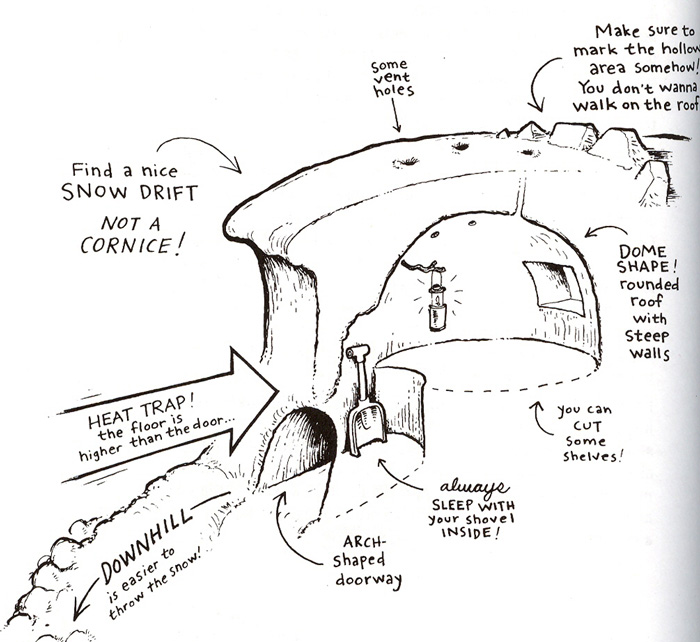
From Allen and Mike's Really Cool Backcountry Ski Book, illustrated by Mike
Clelland
Update for this page:
Here are several examples of "snow shelters"
constructed in a clinic setting over a four hour period in nice weather by
fourteen people armed with several snow shovels. Only one cave meets the design
criteria set forth above. All are very small, having been constructed for one
two and three backcountry travelers.
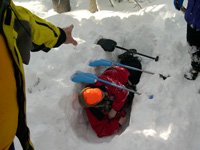
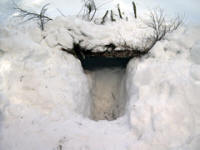
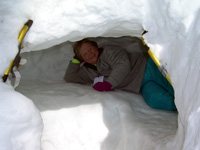
Three hasty shelters of the type suggested by some Search and
rescue folks. Not very safe for a climber on the verge of hypothermia. They
could all be improved by forming an adequate entrance below the vented sleeping bench.
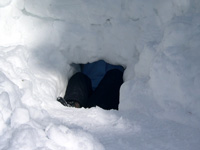
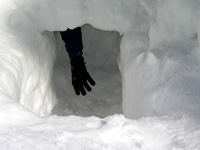
This was the only example of a cave that would maintain a
relatively warm temperature inside since the top of the doorway was below the sleeping
bench. Note the arm hanging down from the recumbent climber. The entrance can be
closed with packs and shovels. This cave did not have air holes. The entrance and
cave were too small for claustrophobic climbers and could have been made larger
with two shovels working.
Copyright© 2004 - 2011 Robert Speik. All Rights Reserved.
![]()
![]()
![]() WARNING - *DISCLAIMER!*
WARNING - *DISCLAIMER!*
Mountain climbing has inherent dangers that can, only in part, be mitigated
Read more . . .
Why are snowcaves dangerous?
Why are Space Blankets dangerous?
What about Hypothermia?
What about snow camping?
Lost and Found
Missing California family found, dad dies from exposure and hypothermia
Missing man survives two weeks trapped in snow-covered car
Missing snowmobile riders found, Roger Rouse dies from hypothermia
Longacre Expeditions teen group rescued from the snowdrifts above Todd Lake
Lost climber hikes 6.5 miles from South Sister Trail to Elk Lake
Hiking couple lost three nights in San Jacinto Wilderness find abandoned gear
Expert skier lost five days in North Cascades without Essentials, map and compass
Climber disappears on the steep snow slopes of Mount McLaughlin
Hiker lost five days in freezing weather on Mount Hood
Professor and son elude search and rescue volunteers
Found person becomes lost and eludes rescuers for five days
Teens, lost on South Sister, use cell phone with Search and Rescue
Lost man walks 27 miles to the highway from Elk Lake Oregon
Snowboarder Found After Week in Wilderness
Searchers rescue hiker at Smith Rock, find lost climbers on North Sister
Girl Found In Lane County After Lost On Hiking Trip
Search and rescue finds young girls lost from family group
Portland athlete lost on Mt. Hood
Rescues after the recent snows
Novice couple lost in the woods
Broken Top remains confirmed as missing climber
Ollalie Trail - OSU Trip - Lost, No Map, Inadequate Clothing
Real Survival Strategies
FREE Clinic on Real Survival Strategies and Staying Found with Map, Compass and GPS together
What do you carry in your winter day and summit pack?
Why are "Snow Caves" dangerous?
Why are "Space Blankets" dangerous?
Why are "Emergency Kits" dangerous?
How can you avoid Hypothermia?
Missing climbers on Mount Hood, one dies of exposure, two believed killed in fall
Missing California family found, dad dies from exposure and hypothermia
Missing man survives two weeks trapped in snow-covered car
Missing snowmobile riders found, Roger Rouse dies from hypothermia
Olympic Champion Rulon Gardner lost on snowmobile!
Lost Olympic hockey player looses feet to cold injury
Expert skier lost five days near resort in North Cascades without map, compass, gps or cell phone
Mount Hood - The Episcopal School Tragedy
Mount Hood - experienced climbers rescued from snow cave
How can you learn the skills of snow camping?
Prospectus
Your Essential Light Day Pack
What are the new Ten Essential Systems?
What does experience tell us about Light and Fast climbing?
What is the best traditional alpine mountaineering summit pack?
What is Light and Fast alpine climbing?
What do you carry in your day pack?
Photos?
![]()
What do you carry in your winter day pack?
Photos?
![]()
What should I know about "space blankets"?
Where can I get a personal and a group first aid kit?
Photos?
Carboration and Hydration
Is running the Western States 100 part of "traditional mountaineering"?
What's wrong with GORP?
Answers to the quiz!
Why do I need to count carbohydrate calories?
What should I know about having a big freeze-dried dinner?
What about carbo-ration and fluid replacement during traditional alpine climbing?
4 pages in pdf
![]()
What should I eat before a day of alpine climbing?
About Alpine Mountaineering:
The Sport of Alpine Mountaineering
Climbing Together
Following the Leader
The Mountaineers' Rope
Basic Responsibilities
![]() Cuatro Responsabiliades Basicas de Quienes Salen al Campo
Cuatro Responsabiliades Basicas de Quienes Salen al Campo
The Ten Essentials
![]() Los Diez Sistemas Esenciales
Los Diez Sistemas Esenciales